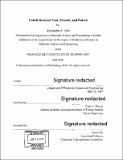| dc.contributor.advisor | Elsa A. Olivetti. | en_US |
| dc.contributor.author | Zele, Alexandra A. (Alexandra Astrid) | en_US |
| dc.contributor.other | Massachusetts Institute of Technology. Department of Materials Science and Engineering. | en_US |
| dc.date.accessioned | 2018-11-15T16:35:14Z | |
| dc.date.available | 2018-11-15T16:35:14Z | |
| dc.date.copyright | 2018 | en_US |
| dc.date.issued | 2018 | en_US |
| dc.identifier.uri | http://hdl.handle.net/1721.1/119069 | |
| dc.description | Thesis: S.B., Massachusetts Institute of Technology, Department of Materials Science and Engineering, 2018. | en_US |
| dc.description | Cataloged from PDF version of thesis. | en_US |
| dc.description | Includes bibliographical references (pages 65-66). | en_US |
| dc.description.abstract | Cobalt has become more and more popular in the realms of academia, industry, and media due to its integral role in many of the most commonly-used lithium-ion battery cathodes today. Many issues have been evaluated regarding the controversial labor and volatile sociopolitical environments associated with cobalt mining and concerns over the ability of cobalt supply to continue to meet demand, especially the increasing demand due to the electric vehicle revolution. Cobalt is a critical element in a variety of products outside of the battery industry, including: superalloys, hard-facing metals, cutting tools, magnets, chemical catalysts, and pigments. In this thesis, I assessed the criticality of cobalt demand in non-battery sectors with the intention of assessing whether demand of cobalt in its traditional, inelastic sectors will supply be a limiting factor of technological progress by 2030 and by 2050. In order to do so, data was collected on the past and present demands of cobalt in its four primary sectors, outside of batteries: superalloys, cutting tools and hard-facing metals, magnets, and chemical catalysts. Future demand projections were made based on the historic data as well as via a bottom-up approach from industry projections for future product demand and cobalt intensity of products. Substitutes for cobalt in these applications were also investigated and are discussed below. The prices at which substitutes become more favorable than cobalt were also evaluated. | en_US |
| dc.description.statementofresponsibility | by Alexandra A. Zele. | en_US |
| dc.format.extent | 66 pages | en_US |
| dc.language.iso | eng | en_US |
| dc.publisher | Massachusetts Institute of Technology | en_US |
| dc.rights | MIT theses are protected by copyright. They may be viewed, downloaded, or printed from this source but further reproduction or distribution in any format is prohibited without written permission. | en_US |
| dc.rights.uri | http://dspace.mit.edu/handle/1721.1/7582 | en_US |
| dc.subject | Materials Science and Engineering. | en_US |
| dc.title | Cobalt demand : past, present, and future | en_US |
| dc.type | Thesis | en_US |
| dc.description.degree | S.B. | en_US |
| dc.contributor.department | Massachusetts Institute of Technology. Department of Materials Science and Engineering | |
| dc.identifier.oclc | 1057895185 | en_US |
